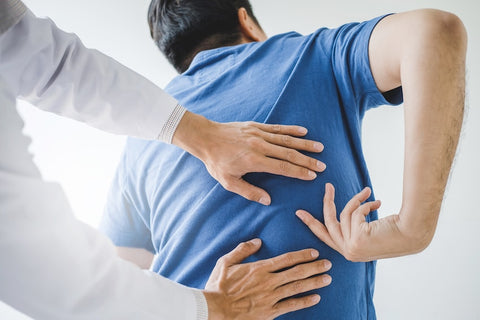
MSD Prevention by ergonomics

Musculoskeletal disorders are the cause of many diseases and accidents related to work in every business sector. In order to prevent and avoid these disorders, it is essential to implement a sustainable and efficient strategy through ergonomics. Indeed good adapted ergonomics can help reducing musculoskeletal disorders.
Zoom on different ergonomics solutions to prevent MSD within the work environment.
What is MSD?
Musculoskeletal disorders called MSD refer to lesions touching mainly structures around articulations and the spine: tendons, nerves, muscles, ligaments, cartilage. Generally speaking, MSD are characterized by discomfort and mild to hard pain that can lead to a handicap. They are often located on the lower back (lumbago, sciatic), on the neck (neck pain), on wrist (carpal tunnel syndrome), on shoulders (rotator cuff syndrome, capsulitis) and on elbow (epicondylitis). They can also be located on knees (hygroma, knee pain) or ankles (sprain).
Musculoskeletal disorders are generally progressive. They can be consequences of extra- professionals’ factors (age, gender, disease), but are mainly due to professional activity. MSD can be developed by biomechanical factors (excessive and repetitive solicitation of muscles, constraining postures, static position or sedentariness, mechanical vibrations) , environmental factors (lighting failure, volume too loud, bad temperature or climatic conditions), organizational factors (work rhythm too strict, lack of recovery time, staggered working hours...), psychosocial factors (work pressure, bad working environment, dissatisfaction of daily working routine). It is important to know that MSD are recognized as a professional disease in the global system.
What role has ergonomics in MSD prevention?
In every business sector, ergonomics means work adaption to the worker. The main ergonomics objective is to adapt work to humans taking into account physical capacities and implementing adapted methods, efficient organization and adequate working environment. The implementation of good ergonomics at work will allow companies to increase their productivity while ensuring workers comfort, health and security. This will also help workers to improve their company's economic performance in the way that adapted ergonomics will reduce absenteeism due to MSD working accidents.
What are the MSD ergonomics prevention action?
In order to avoid MSD that has consequences on workers health, the implementation of a sustainable efficient strategy is necessary. To prevent MSD, it is necessary to previously identify different risk factors in the company, so it’ll be easier to adapt different actions depending on the situation.
- Working organization (alternate tasks, handle work rhythm, change work position, be sure to have enough breaks)
- Space and work position adaptation (convert an adequate working area, ease the access to workstation, equalize the floor, change lightning)
- Invest in equipment and material in order to reduce distance (footstool, scale, hook)
- Provide tools and machines that ease load manipulation and transport (freight-elevator, lift trucks, hoist...)
- Adapt tools and machines (mechanize machines, maintain devices with a support or manipulator)
In industrial and tertiary sectors particularly, that require load manual manutention, prevention of MSD by ergonomics will be mostly on workstation adaptability taking into account individual shape and their daily tasks. For that, it is necessary to invest in ergonomics workstation, height adjustable and flexible, light and handy materials (rolling device, security wooden grating) that will fit the worker's needs.
Stock&Roll, an ergonomic solution to prevent MSD
As known, in numeric print workshops, manipulation and transport of paper rolls, sheet rolls or adhesive films from the storage place to the machine require repetitive movement in a day. Moreover, heavy load or unequal floor may influence workers body balance at the time of manutention. These factors may lead to workers MSD risk accidents.
Aware of these risks, Stock & Roll proposes an ergonomics solution for every worker that has to handle heavy rolls (large format digital print workshop, for graphic art professionals, decorative services, sign makers...). More precisely, it’s about rolling devices designed to ease large format rolls storage and transport. With Stock&Roll products, your adhesive rolls or your sheet rolls can be carried easily on every type of floor thanks to high performance wheels. Rolls are easy to handle thanks to a roll support patented system. Rolls are always clean and can’t fall accidently on the ground anymore. Stock&Roll products have a specific space dedicated to roll fast identification. Cleanliness, agility and security are Stock & Roll’s key words.
Your questions and answers about MSD prevention by ergonomics
What are the main causes of MSD?
There are several MSD risk factors: constraining posture, frequent or repetitive gestures using the same muscles and joints, heavy load manutention and transport, static position, working environment or workstation not fitted to workers, too long vibration exposure, lack of breaks or even lack of recovery time.
How to recognize MSD?
MSD symptoms evolve in different stages. First stage is characterized by a functional discomfort during the activity that stops when resting. During the intermediary stage, discomfort and pain start to reduce work capacity. At the final stage of proven pathology, heavy symptoms such as joint stiffness, redness, swelling and other inflammation consequences lead to full work incapacity.
What are MSD solutions?
Prevention is definitely the best solution. To reach a good efficient prevention, an investment in ergonomics material and equipment is to be implemented. This will also reduce work drudgery while earning productivity time. It is also necessary to adapt a safe and adapted working environment and working station for workers. Training can also be useful to sensitize workers about MSD risks and help them reduce or avoid these disorders.




